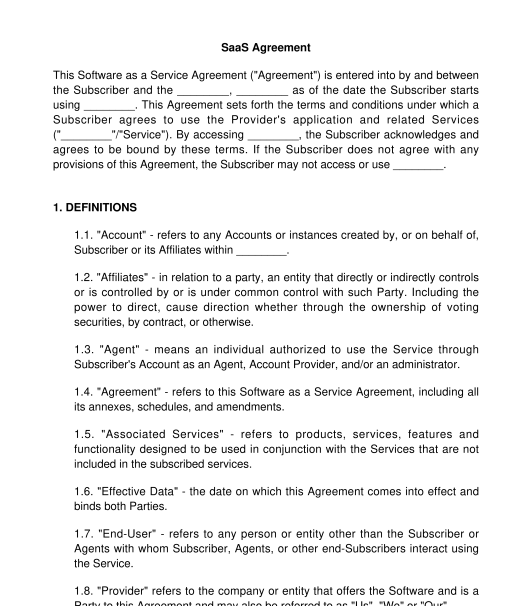 06-09-2025
06-09-2025

Answer a few questions and your document is created automatically.

Your document is ready! You will receive it in Word and PDF formats. You will be able to modify it.

 06-09-2025
06-09-2025
 Word and PDF
Word and PDF
 17 to 26 pages
17 to 26 pages



The Software-as-a-Service Agreement ("SaaS Agreement") is a comprehensive legal document designed to help businesses involved in the software industry to create clear terms and conditions for their Software-as-a-Service (SaaS) offerings.
The Saas Agreement helps business to outline the rules and procedures on how their online platforms or online applications should be used by the end-users (customers).
SaaS refers to a cloud-based model (stored in remote servers) where software applications are accessed over the internet, allowing users to benefit from powerful features without the need for heavy hardware, installation, or maintenance.
Software as a service (SaaS) allows users to connect to and use cloud-based apps over the Internet. Common examples are email, calendaring, and office tools (such as Microsoft Office 365, Gmail, Facebook, and many others).
Software is computer programs or apps that help us do different tasks on our computers or devices. It can be anything from simple text editor to complex video editing or accounting software. Software as a Service (SaaS) is a way of using software where the user doesn't have to download or install it on their devices to use it. Instead, we can directly access and use it over the internet using an internet browser like Google Chrome, Microsoft Edge, etc.
When a company offers a platform or software through SaaS, they give the business or people the right to use their software online without transferring any ownership rights. These permissions or arrangements are called licenses that outline the rules for using the software. The rules for this kind of licensing specify things like how many people can use the software, how long they can use it, and any limitations or restrictions. This is the way the software company protects their software and any unauthorized use or misuse.
The SaaS Agreement and Website Terms and Conditions are different documents. SaaS is about the rules and regulations pertaining to the use of software online without downloading it. It is only applicable when someone subscribes to the SaaS. On the other hand, Website Terms and Conditions are rules and regulations concerning the use of a website. Whenever a user visits a website, the Website Terms and Conditions will be applicable to such users.
You can use this Agreement by filling in the relevant details of your SaaS service. The Agreement helps in defining the rights, obligations, and limitations of both the service provider and the user/subscriber. It is essential to carefully review and understand the Agreement, making any necessary modifications to ensure it aligns with your specific business requirements.
Major clauses covered under this Agreement are:
To make the Agreement a valid document you can either take a printout and get it signed by both parties, but, since it is a SaaS product, it is not viable to get each agreement signed in physical copies. For this, you can take the customer consent online by implementing a robust solution, including a secure and reliable online consent mechanism, such as a checkbox or "I Agree" button, to capture customer consent. The consent data shall include the date, time, and relevant customer details associated with the consent. You need to make sure the mechanism used to take consent from the customer complies with the applicable laws of the jurisdiction where the consent has been taken.
The general laws applicable to a SaaS Agreement in India are Information Technology Act, 2000, Indian Contract Act, 1872, Consumer Protection Act, 2019.
You fill out a form. The document is created before your eyes as you respond to the questions.
At the end, you receive it in Word and PDF formats. You can modify it and reuse it.
Guides to help you
SaaS Agreement - Template, online sample - Word and PDF
Country: India